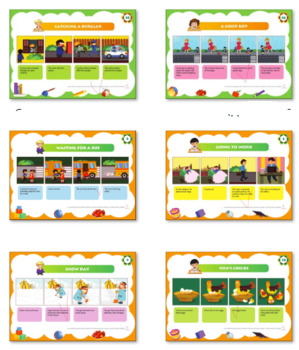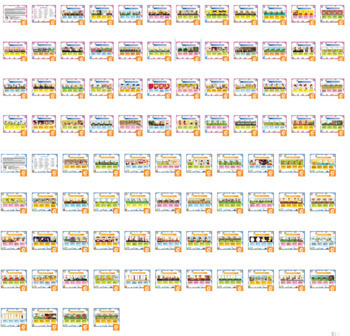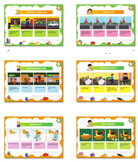SUPER BUNDLE: Sequence, Sequencing Stories with Pictures, retelling stories
- Zip
Products in this Bundle (4)
Also included in
- Do you know a child who is not able to set the table? The child struggles with what should be done first and where everything goes. Do you know a child who can’t follow the specific “order” of steps to solve math problems correctly? Do you know a child who struggles to tell you about their school daPrice $54.40Original Price $136.00Save $81.60
- THIS MEGA MEGA BUNDLE IS SO FANTASTIC THAT YOU SHOULD NOT MISS.IT TOOK ME THREE YEARS TO CREAT AND IT IS OUTSTANDING!There are all together 1400 pages with beautiful colours and pictures. Your kids will love them!Do you know a child who is not able to set the table? The child struggles with what shoPrice $120.00Original Price $358.00Save $238.00
- BESTSELLER: 334 WONDERFUL SEQUENCING STORIES INCLUDED IN THIS SUPER BUNDLE:184 AMAZING STORIES ABOUT DAILY LIFEA broken vaseLost umbrellaBrushing your teethA good dogPet groomingMaking a sandwichBuilding a scooterA field mouseBreakfast surpriseAlphabetBalloon stuck in a treePlanting a treeCleaning yPrice $38.40Original Price $116.00Save $77.60
Description
184 WONDERFUL SEQUENCING STORIES INCLUDED IN THIS SUPER BUNDLE:
- A broken vase
- Lost umbrella
- Brushing your teeth
- A good dog
- Pet grooming
- Making a sandwich
- Building a scooter
- A field mouse
- Breakfast surprise
- Alphabet
- Balloon stuck in a tree
- Planting a tree
- Cleaning your room
- Cats love fish bones
- Doll’s laundry
- Catching a burglar
- Helping a cat
- Eating ice-cream
- Balloon pops
- Hot sun
- A boy and his kite
- Washing dishes
- Going fishing in a pond
- A poor bird!
- Building blocks
- Feeding the birds
- Sandcastle
- A bird and a fox
- Washing the car
- A warm jacket
- Out of the cocoon
- A wet chair
- Making popcorn
- A beach day
- Getting a haircut
- A good boy
- Oh, my coffee!
- Sending a letter
- A gift
- A hungry dog
- Birthday party
- Birds love breadcrumbs
- A clown
- Disappearing act
- A hungry fish!
- Milking a cow
- Waiting for a bus
- Cleaning up litter
- Woolly sheep
- A happy snake
- Getting dressed
- Clean hands
- New haircut
- Smashing the sandcastle
- Apple-tree accident
- Good night!
- Making tea
- Let’s get ready
- Going to work
- The cat and the yarn
- The morning
- Hiding the bone
- A sweet dolphin
- Stolen milk
- The life cycle of a frog
- Visiting grandma
- A magician
- Laundry day
- Strike
- Flowers blooming
- Hen’s chicks Accident
- Swim ring
- A tree grows
- A fruit bowl
- High tide!
- Catching a butterfly
- Picture day
- Bye bye
- Mr. Snowman
- Making acorn horses
- Building an airplane
- Snow day
- The pelican surprise!
- Sewing your own dress
- Chewing a bone
- Let’s grow a tree
- A nice turtle
- Be careful!
- Classroom
- The big carrot
- A growing girl
- Where is the popcorn?
- Rainy-day ready
- Spooky ghost
- Be careful with hoses
- Making jam
- The goat and the troll
- Magic hat
- Birthday cake
- Dentist visit
- A Christmas tree
- A pretty picture
- A growing baby
- A bubble bath
- Picnic
- Present for mother
- Sunflower
- A glass of water
- School day routine
- Wolf in the chimney
- A friend with a long neck
- Nightly routine
- A birdhouse
- A good bath
- Homemade - lemonade
- A surprise
- Hilltop slip
- Gift wrapping
- Cat fight
- Baking a Pizza
- Falling Leaves
- Flying kite
- Hiking
- New haircut
- Washing your hands
- Dolly doctor
- Don’t climb!
- Music in the night
- Washing the dog
- Helping the elderly man
- Watermelon slices
- Biting the Ball
- Apple rain
- Playing football
- Babysitting birds
- Washing a T-shirt
- Setting the table
- From tree to chair
- Cat scratch
- Stopped by a rock
- Building a chair
- Having a guest over
- Arts and crafts
- Drawing
- Mother raising a daughter
- Play, then bathe
- Piñata party
- Egg hatches!
- Blowing balloons
- A soapbox car
- Sliding down a slide
- A sweet grandchild
- Folding clothes
- Dogs love bones
- Setting up a swing rack
- Growing tomatoes
- Getting cold
- A dark duckling
- Building a birdhouse
- Boys on a beach
- Building a house
- Playing in a tunnel
- Yummy ice-cream!
- Putting a puzzle together
- Feed a rabbit
- The winner
- Where is my dog?
- Bird in a boat
- Buying a gift
- Don’t play on the table
- Freeing a caged bird
- A candle’s life
- A letter to Santa
- Wrapping a gift
- Ice-skating accident
- Putting clothes on
- Elephant shower
- Astronaut’s dream
- Toilet hygiene
- A superhero
- Dairy products
- Ball indoors
- Kite stuck in a tree
- A nice sweater
Do you know a child who is not able to set the table? The child struggles with what should
be done first and where everything goes.
Do you know a child who can’t follow the specific “order” of steps to solve math problems correctly?
Do you know a child who struggles to tell you about their school day? When they try to tell you about it, their story may be jumbled and hard to follow.
If yes, then these kids may have trouble with sequencing. Sequencing is such an important tool to learn for our students because it affects their ability to tell a story, comprehend a book, retell a story they read, order events to make a plan, or tell you about something they did. That is why sequencing has a huge impact on literacy, language, communication, and social interaction. It is a must-teach skill in a developmental curriculum.
Language is the very first thing kids learn to sequence. They know that when they use words and sounds in a particular order, they get certain results. Language issues aren’t the only reason for trouble with sequencing tasks. Working memory issues cause some children to lose hold of the proper order of doing things.
Teaching sequencing is considered one of the most important things in speech therapy. It is a critical communication and life skill. Sequencing is the process of combining things in a particular order – the following of one thing after another. In the context of speech and language, sequencing refers to a skill that we use to discover the components of an event and break it down into simple steps, such as the beginning, the middle and the end of an event. It also refers to the ability to align thoughts, language, knowledge, information or actions in a certain order and retrieve them to complete a given task.
We use sequencing skills in all areas of our life and don’t even realize it. You use these skills to follow multi-step directions, complete a math problem, break a big task into small tasks, form complete sentences with the correct syntax, or to retell a story.
Sequencing, sequence, Sequencing Stories with Pictures,retelling stories,retell
Our sequencing stories are teacher-approved for language and speech therapy students. Each story contains four pictures with simple sentence descriptions. These will strengthen our children’s sequential auditory skills as well as logical thought and visual memory process. Our children will improve their communication skills as they retell each story in their own words.
Sequencing skills are an important part of language development. The ability to sequence is one of many skills that contributes to students' ability to comprehend what they read. Sequencing is a foundational skill to many aspects of language, executive functioning skills, and other areas of academics. Sequencing is a common area that children struggle with. If they don’t develop a strong foundation when they are young, it’s easy to get behind and it can affect many areas of their lives. Sequencing difficulties can be a result of language deficits, executive functioning issues, or lack of attention skills.
Sequencing is the ability to arrange language, thoughts, information and actions in a certain order to get things done. Without this skill, it’s hard to complete tasks correctly. And it’s often the reason why some kids seem unable to follow simple directions.
It is very likely that trouble with sequencing language will cause problems for the child down the line. Without those early skills, kids have a harder time developing a natural sense of how other things should be ordered. Younger children who have trouble with sequencing often struggle with sequences of pretend play. They might also say sentences in a muddled order or say things that seem unrelated to the topic.
Older or more verbal children who struggle with sequencing often find it hard to tell a story or a piece of news; as they jump backwards and forwards and miss important parts out. They might not be able to answer the question they were asked or may waffle and fail to come to the point.
Sequencing is also an important reading comprehension strategy. It allows students to make sense of how events unfold in their reading. In turn, these reading skills will help students in their own writing. It will help them to construct a cohesive and logical flow to their writing that readers can easily follow.
Strong sequencing skills help students:
○ With their reading comprehension of a text, especially narrative texts.
○ Understand the structure of a text and how it is put together.
○ Understand how texts are kept cohesive through the use of linking devices such as connectives and transitions.
○ Organize information and ideas in their own writing.
○ Develop problem-solving skills that are important in other curriculum areas too.








